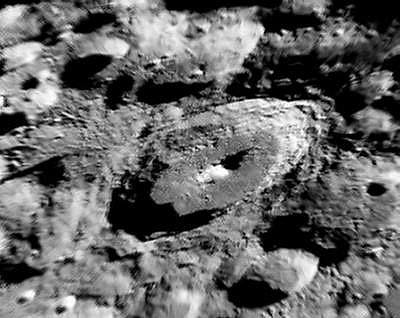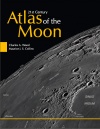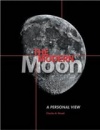Difference between revisions of "June 27, 2004"
| Line 20: | Line 20: | ||
<table class="story" border="0" bgcolor="#FFFFFF" width="90%" cellpadding="10" align="center"><tr><td> | <table class="story" border="0" bgcolor="#FFFFFF" width="90%" cellpadding="10" align="center"><tr><td> | ||
<p class="story" align="center"><b>An Older Tycho</b></p> | <p class="story" align="center"><b>An Older Tycho</b></p> | ||
| − | <p class="story" align="left">Have you ever set up your telescope when the Moon is about 9 days old and scanning the terminator said, "Must be a great libration, Tycho is pretty far south tonight"? I have, and then I realized that I've been fooled once again by Tycho's look-alike, Moretus. Like the pair [[June_26,_2004|Eratosthenes]] and [[February_4,_2004|Copernicus]], Moretus is the older and over-shadowed lesser twin of one of the best known craters on the Moon. But Moretus is worth a second look for it is another classic example of a complex lunar crater. Its 114 km diameter rim steps down via one large scarp and a jumble of terraces to a flat floor 3.95 km below the rim crest. John's photo shows parallel banding in the wall - traces of the original terraces. The floor is mostly smooth (impact melt?) and this Lunar Orbiter IV [ | + | <p class="story" align="left">Have you ever set up your telescope when the Moon is about 9 days old and scanning the terminator said, "Must be a great libration, Tycho is pretty far south tonight"? I have, and then I realized that I've been fooled once again by Tycho's look-alike, Moretus. Like the pair [[June_26,_2004|Eratosthenes]] and [[February_4,_2004|Copernicus]], Moretus is the older and over-shadowed lesser twin of one of the best known craters on the Moon. But Moretus is worth a second look for it is another classic example of a complex lunar crater. Its 114 km diameter rim steps down via one large scarp and a jumble of terraces to a flat floor 3.95 km below the rim crest. John's photo shows parallel banding in the wall - traces of the original terraces. The floor is mostly smooth (impact melt?) and this Lunar Orbiter IV [http://www.lpi.usra.edu/research/lunar_orbiter/images/img/iv_130_h2.jpg image] reveals a narrow rille that seems unusual for impact melt. There is also a large central peak and some low hills, especially to the west. Orbiter images also show subdued secondary craters to the northwest, and a search at full Moon shows that Moretus is invisible - no rays nor rim brightness remain. The lack of rays is consistent with the number of superposed impact craters on Moretus' floor - it is an older crater of [[February_23,_2004|Eratosthenian]] age. </p> |
<blockquote> | <blockquote> | ||
<p align="right" class="story">— [mailto:tychocrater@yahoo.com Chuck Wood]</p></blockquote> | <p align="right" class="story">— [mailto:tychocrater@yahoo.com Chuck Wood]</p></blockquote> | ||
| Line 27: | Line 27: | ||
<p class="story"><b>Related Links:</b><br> | <p class="story"><b>Related Links:</b><br> | ||
[http://www.jsussenbach.nl/ Sussenbach's Digital Astroimaging Site]<br> | [http://www.jsussenbach.nl/ Sussenbach's Digital Astroimaging Site]<br> | ||
| − | [ | + | [http://www.lpi.usra.edu/research/lunar_orbiter/images/img/iv_118_h2.jpg Lunar Orbiter IV View] |
</p> | </p> | ||
<p><b>Yesterday's LPOD:</b> [[June 26, 2004|An Older Copernicus]] </p> | <p><b>Yesterday's LPOD:</b> [[June 26, 2004|An Older Copernicus]] </p> | ||
Latest revision as of 22:39, 8 February 2015
An Older Tycho
Image Credit: John Sussenbach |
|
An Older Tycho Have you ever set up your telescope when the Moon is about 9 days old and scanning the terminator said, "Must be a great libration, Tycho is pretty far south tonight"? I have, and then I realized that I've been fooled once again by Tycho's look-alike, Moretus. Like the pair Eratosthenes and Copernicus, Moretus is the older and over-shadowed lesser twin of one of the best known craters on the Moon. But Moretus is worth a second look for it is another classic example of a complex lunar crater. Its 114 km diameter rim steps down via one large scarp and a jumble of terraces to a flat floor 3.95 km below the rim crest. John's photo shows parallel banding in the wall - traces of the original terraces. The floor is mostly smooth (impact melt?) and this Lunar Orbiter IV image reveals a narrow rille that seems unusual for impact melt. There is also a large central peak and some low hills, especially to the west. Orbiter images also show subdued secondary craters to the northwest, and a search at full Moon shows that Moretus is invisible - no rays nor rim brightness remain. The lack of rays is consistent with the number of superposed impact craters on Moretus' floor - it is an older crater of Eratosthenian age. Technical Details: Related Links: Yesterday's LPOD: An Older Copernicus Tomorrow's LPOD: LACs and More! |
Author & Editor: |
COMMENTS?
Register, Log in, and join in the comments.




